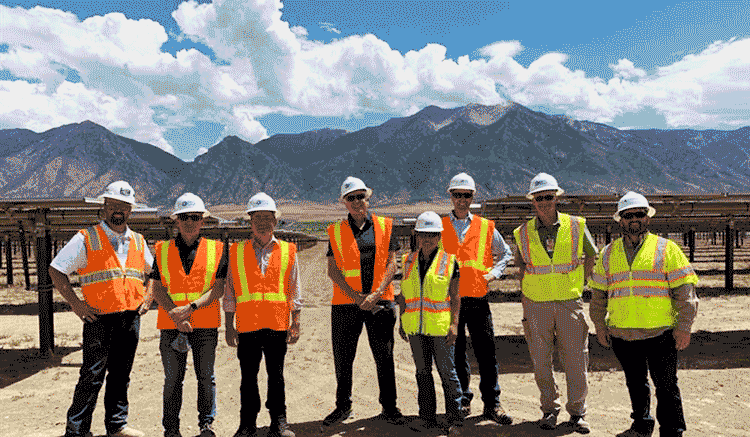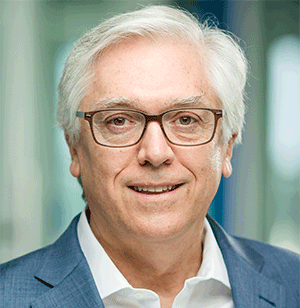The 2022 CEOs Who 'Get It'

Andrés Gluski
President and CEO
AES Corp.
Arlington, VA

Andrés Gluski (center)
The AES Corp. is a Fortune 500 global energy company accelerating the future of energy. Together with its many stakeholders, it’s improving lives by delivering the greener, smarter energy solutions the world needs. Its diverse workforce of 8,000 employees is committed to continuous innovation and operational excellence, while partnering with its customers on their strategic energy transitions and continuing to meet their energy needs today.
Describe your personal journey to becoming a CEO who “gets it.”

The electricity we generate and distribute provides safe, reliable and sustainable energy to tens of millions of people. We simply cannot achieve our mission without considering safety and the environment. If we do not act in a safe manner, we cannot deliver reliable or sustainable energy solutions. That’s why our No. 1 value at AES is “safety first.”
One of our themes at AES is to take safety personally. This means asking yourself: “What can I do to keep myself and my colleagues safe so that we can go home to our loved ones each day?” As CEO, I feel the responsibility to keep all of our people safe – 8,000 people across 14 countries.
In 2005, we realized we needed to have environmental, health and safety standards across every country where we work. I ensured we had the comprehensive safety manuals and the right procedures in place to keep our people safe. I also made sure people received the training and personal protective equipment they needed to safely do their jobs. When there was an incident, we began sharing that information openly across the company to help us learn from what happened and prevent it from happening again.
We have made significant progress. When we compare the time period of 2008-2014 with 2015-2021, AES fatalities decreased 67% and contractor fatalities decreased 59%, with an overall reduction of 62%.
We recognize that one fatality is too many. We are always evaluating and implementing new ways of working to keep our people safe – to instill a culture of “safety first” – and expanding how we define safety to have a holistic approach, such as measures to incorporate mental health and wellness and, of course, navigating an unprecedented pandemic.
Why is safety a core value at your organization?
For AES people, how we accomplish our successes and deliver our product is as important as the services we provide. We share a vision of being the world’s leading power company by safely providing affordable and sustainable energy, and we also share a common set of values that defines how we work toward that vision on a daily basis. Every day our people put their lives on the line to bring us energy, which is why putting safety first is our first value. Nothing else we do is more important than the lives of our people, our contractors and the communities we serve.
In fact, a portion of executive compensation is tied to AES’ safety performance for both lagging and leading indicators. Executive compensation comprises key performance indicators in five key areas tied to our strategy, and it is crucial that we apply the same weight and significance to our No. 1 value of “safety first” as we are to the other focus areas of our mission.
What is the biggest obstacle to safety at your organization, and how do you work to overcome it?
As I mentioned, AES is a Fortune 500 energy company with over 8,000 people across 14 countries and four continents today. This means navigating the potentially life-threatening hazards of electricity and solving the additional challenge of instilling a unified safety culture in the transmission field, at our power plants and in the less hazardous office environment, across our global markets. Our priority is to instill a culture of safety first no matter where our people live or what their role is.
One practice that distinguishes how we work is what we call stop-work authority. Stop-work authority gives every person – AES people, contractors, construction contractors – the power and authority to stop work if they see something unsafe, or if they believe they see something with the potential to become unsafe. No questions asked. This is not only a practice our people are encouraged to use, but it is their responsibility to use it. Stop-work authority is one way we instill a mindset of safety first on and off the job.
How do you instill a sense of safety in employees on an ongoing basis?
We encourage our people to lead with safety and to set the right example. The safe example. Other people will follow in these footsteps, and when they do, we’ll achieve our goal of creating and sustaining a workplace free of incidents.
Talking about safety and evaluating how safe we are is a daily activity at AES. We have a comprehensive safety management system in place in each of our markets that provides a consistent framework, a diverse and comprehensives internal safety communications cadence, and a robust reporting system. We can always do more. As a company, we lead by example through continuous improvement.
Innovation is core to who we are as a company, and our approach to safety is no different. As part of AES’ digital strategy, we launched Smart Safety, which meant incorporating digital tools to accelerate our safety efforts as part of our overall digital strategy. The implementation of new tools can be a tremendous undertaking, from selection, onboarding, change management and cost. But we believe the value of new digital tools is critical to maintaining and continuously improving AES’ safety culture and safety performance.
This includes technologies, such as digital software to support incident investigation. We use software to support and track our proactive safety measures, such as safety inspections and work activity observations. It means using new technologies to increase the safety of our people and communities. Our drone program, for example, has allowed us to eliminate more than 100,000 hours of hazardous work and conduct more than 5,000 hours of aerial inspections of power plant and transmission infrastructures, which eliminates potentially hazardous man-hours.
How does your organization measure safety?
The lagging indicators that inform our safety performance are incidents and fatalities. One fatality is too many, and that’s why we continually evaluate how we can improve and then take action. Leading indicators are proactive metrics that support our goal to reduce significant incident and potential events, which is our equivalent to significant injury and fatality events. SIPs give us insight to activities that are happening while giving us an opportunity to learn from them before an incident happens.
We believe so strongly in the impact of non-injury SIPs that we launched a global non-injury SIP program, which allows us to identify hazards that could lead to serious injuries proactively before a real incident occurs. AES introduced incentives to encourage increased and accurate reporting. Over the years, with the support of leadership, our non-injury SIP rate has improved, which demonstrates our people’s willingness to report in order to accurately assess our safety performance and culture.
In the past seven years, AES’ global fatalities have decreased 62%, and our LTI rates for AES people (0.049), operational contractors (0.065) and construction contractor (0.016) is below Edison Electric Institute’s top decile benchmark of 0.09.
Over the past 15 years, we’ve been working to make a workplace free of incidents a reality. It’s been challenging work that has required the focus of all of our people, but we’ve made significant progress. We are on track to end 2021 with the best ever safety performance for AES. With zero fatalities, we have been able to send everyone back home to their loved ones.
What role does off-the-job safety play in your organization’s overall safety program?
AES comprises a diverse group of people and positions. We have many people who are field workers, and we have many people who are office workers who aren’t facing the dangers of electricity every day. We want “safety first” to be a way of life that people bring to work with them every day and take home to their families.
On a recent safety day – a day we set aside annually to focus on our safety learnings and celebrate our successes – we invited everyone’s family to participate. Our people’s kids participated and created art to answer the question: “What does safety mean to you?” Safety starts at home and is carried into the workplace.
We also place a big focus on education. In El Salvador, for example, we were facing challenges with community safety in which members were coming into contact with electricity. To create a culture of awareness, we started the Energía Mágica (Magic Energy) program in which we provided education to thousands of children on the safe and efficient use of electrical energy. The kids, in turn, educated their parents. Since we started the program in 2007, we have educated more than 640,000 children.
The safety challenges and opportunities differ in each country where we work, and so we tailor our off-the-job safety measures to meet these unique needs and create the most impact.
What have you done to support employee mental health and well-being within your organization?
Our purpose is to accelerate a smarter, greener energy future because that is the safest future our society can achieve. Mitigating the most harmful effects of climate change is a matter of safety. So, it is no surprise that we think beyond the traditional definition of safety to incorporate other areas of safety into our approach, like mental health and wellness.
AES launched an employee assistance program to help our people worldwide put safety first by prioritizing their personal health and wellness and navigating life challenges that come their way.
The EAP provides free counseling services and training solutions to our people and their immediate families and provides numerous resources across a variety of areas – financial, legal, stress, support for new families, relationships and more.
During the COVID-19 pandemic, AES worked to ensure the safety of our people and the communities we serve always came first.
With the early intervention of executive leadership, more than 50% of AES’ workforce was asked to telework. We registered and monitored each and every case within AES, and we have administered more than 130,000 proactive COVID tests to date in our work locations. We developed a comprehensive “Transition Work Back to the Workplace” playbook for each of our markets to utilize and implement in adherence to local government guidelines. Since the pandemic began in February 2020, I’ve hosted twice-monthly live broadcasts with guest health and wellness experts so that our people have an opportunity to have their most pressing questions about the pandemic and AES’ strategy answered. Today, more than 90% of our workforce is now vaccinated.
Thanks to the strength of our COVID-19 response, we were not only able to continue delivering electricity to power critical services, but also provide relief to our local communities. As of August 2020, AES has launched over 50 response initiatives and committed more than $2 million dollars to the markets and communities in which we operate.
Post a comment to this article
Safety+Health welcomes comments that promote respectful dialogue. Please stay on topic. Comments that contain personal attacks, profanity or abusive language – or those aggressively promoting products or services – will be removed. We reserve the right to determine which comments violate our comment policy. (Anonymous comments are welcome; merely skip the “name” field in the comment box. An email address is required but will not be included with your comment.)


